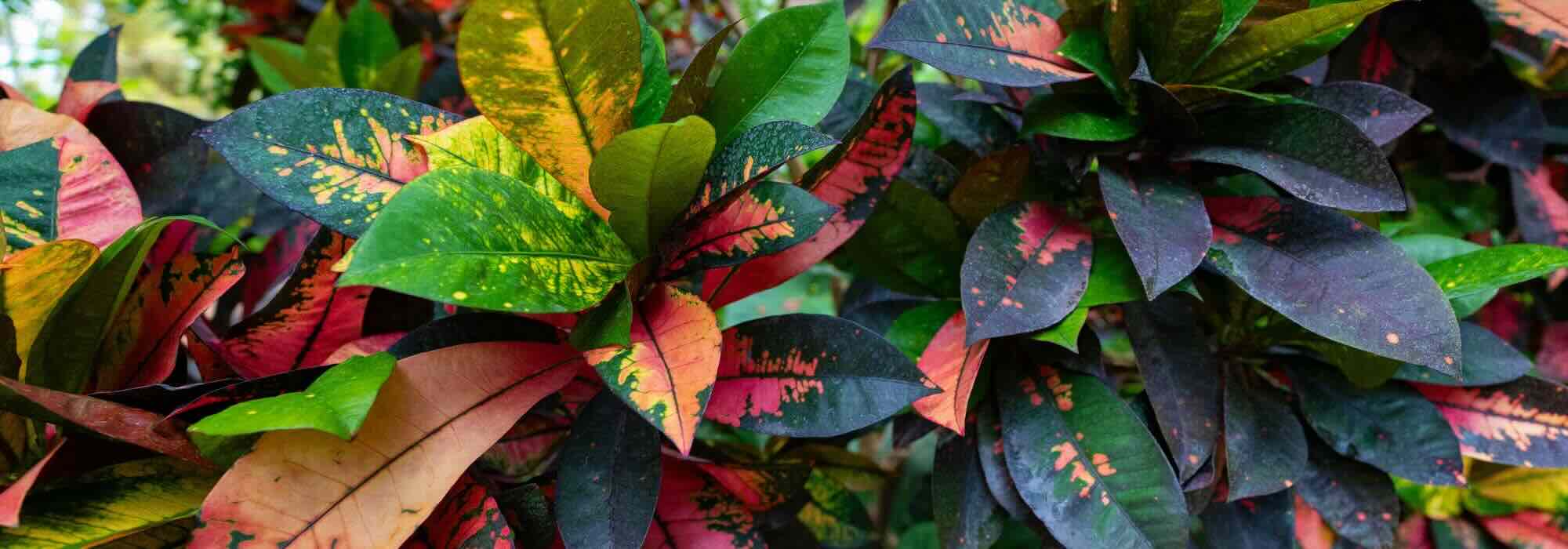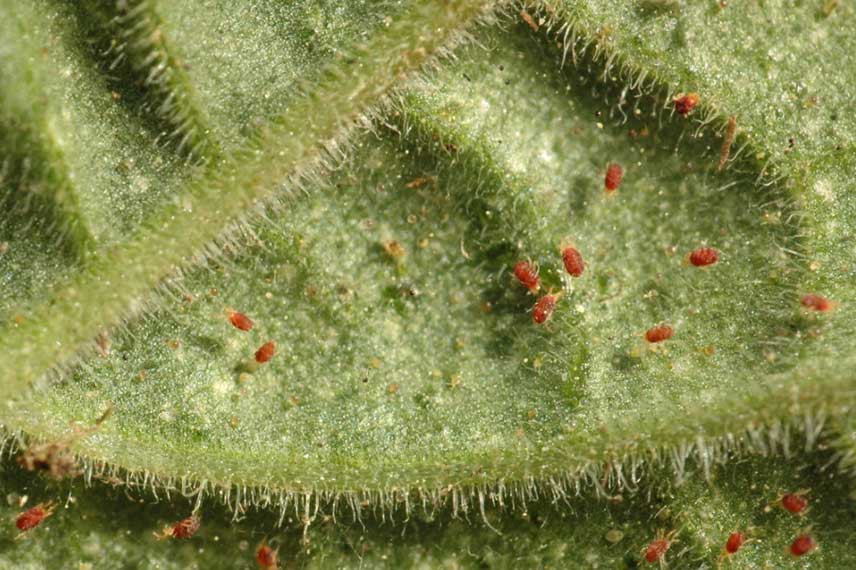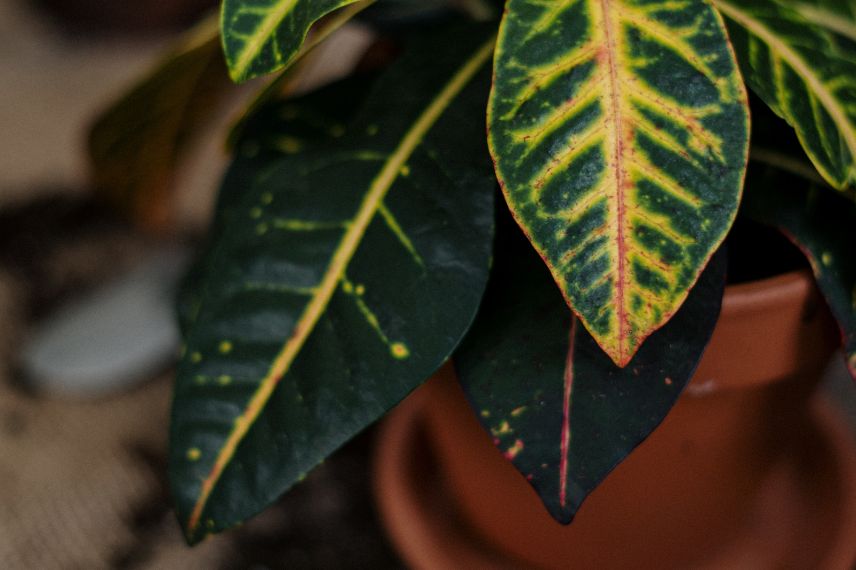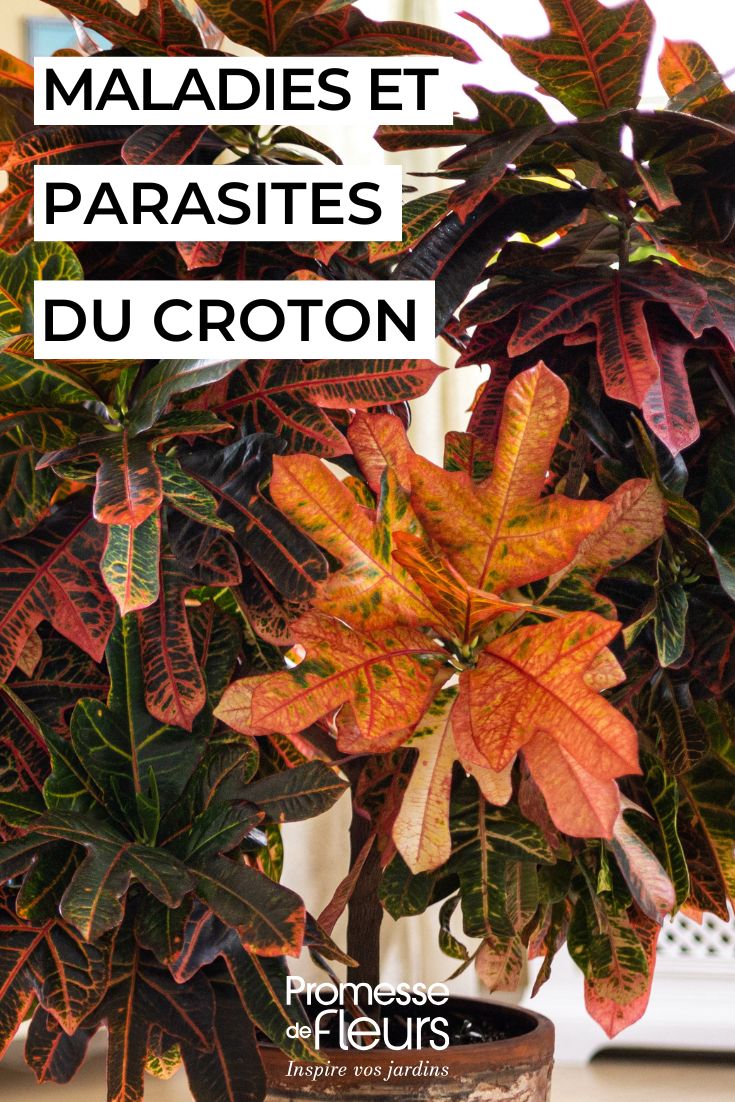
Indoor Croton: Parasitic Pests, Diseases and Common Problems
Prevent and treat naturally
Contents
The Croton (Codiaeum variegatum) is a houseplant with colourful foliage, in vibrant shades of yellow, red, orange and green. Native to Southeast Asia and the Pacific Islands, it brings a tropical touch to our homes. But beneath its robust appearance, the Croton can lose its splendour if its growing conditions are not respected.
Indoors, this plant is sensitive to variations in humidity, light and temperature. When stressed, it may show visible signs such as leaf drop, discolouration or brown tips. Additionally, it can be targeted by parasites like scale insects or spider mites, and suffer from fungal diseases if watering is not properly managed.
Discover in this article how to identify the main causes of these imbalances, practical treatment tips and, above all, effective prevention methods to keep your Croton in top shape all year round.
Common parasitic pests
Mealybugs
Mealybugs are common parasitic pests of the Croton, visible as small cottony clusters attached to the leaves and stems.
A sticky deposit (called honeydew) is often noticeable on the leaves, followed by gradual yellowing. The leaves may eventually fall off. Upon closer inspection, fluffy white clusters can be seen on the undersides of leaves or on the stems.
Infestations mainly occur when the air is too dry or the plant is stressed by improper care, such as irregular watering or lack of light, for example. They can also spread from other infested plants nearby.
Treatment:
- Remove mealybugs with a cotton swab dipped in 70° alcohol.
- Spray a mixture of water and black soap with 1 teaspoon of rapeseed oil and alcohol added.
- Repeat the application several times to eliminate the young stages of the parasites and the eggs.
Prevention:
- Inspect the plant regularly, especially in the leaf axils.
- Maintain good ambient humidity to limit their appearance.
- Isolate new plants before placing them near the Croton.
→ Read our dedicated guide on mealybugs to learn everything about eliminating them.
Spider Mites (Red Spider Mites)
Spider mites are tiny mites that thrive in dry air. They attack leaves by sucking their sap, causing visible damage quickly.
The leaves develop yellow or brown mottling, lose their natural shine, and then dry out. Fine webbing may also appear between the stems and the undersides of the leaves.
These pests particularly develop in winter with heating, when the air is too dry. A warm and low-humidity environment is especially favourable to them.
Treatment:
- Place the plant under the shower and rinse the foliage thoroughly with the showerhead.
- Repeat the process regularly, every 4 to 5 days, to dislodge the insects.
- If the infestation is severe, introduce beneficial insects like Phytoseiulus persimilis, a predatory mite that feeds on spider mites.
Prevention:
- Increase ambient humidity around the Croton by grouping plants together, using a humidifier nearby, or placing the plant in a more humid room like a bathroom or kitchen.
- Mist the leaves regularly with non-calcareous water.
- Monitor the plant, especially during heating periods.
- Avoid placing the Croton in overly hot and dry locations, as it prefers ambient humidity of 50 to 60%.
→ Discover our detailed article on spider mites to learn more about treatments.

Spider mites are barely visible to the naked eye: it’s the damage to leaves or fine webbing that alerts you
Read also
Croton: planting, growing, and careFungal diseases
Even indoors, the Croton can fall victim to fungi, especially if humidity is too high or watering is poorly managed. These diseases mainly affect the roots, but can also impact the foliage in some cases.
Root rot
This fungal disease occurs when the roots are left in excess water, encouraging the growth of pathogenous fungi.
The plant begins to wither without apparent reason: the leaves turn yellow, droop, then fall. When the plant is removed from its pot, the roots are brown, soft, or even foul-smelling—they are in the process of decomposing.
Overwatering, a pot without drainage holes, or overly compact soil prevent water from draining properly. This creates an asphyxiating medium conducive to fungi such as Pythium or Phytophthora.
Treatment:
- Remove the plant from its pot to inspect the condition of the roots.
- Trim all blackened or soft roots with a clean tool.
- Repot in fresh substrate, a high-quality potting soil that is light and well-draining, and in a clean pot with drainage holes. If you tend to overwater, opt for a porous terracotta pot, which allows faster water drainage.
Prevention:
- Allow the soil to dry out slightly between waterings. The Croton needs a slightly moist medium, but never waterlogged.
- Always use high-quality soil with good water retention but that is airy and well-draining (add perlite to improve drainage).
- Empty the saucer after each watering to avoid stagnant water.

If your Croton suffers from overwatering, it’s wise to choose a terracotta pot for it
Physiological and environmental issues
The Croton is sensitive to environmental changes and cultivation mistakes. Several visual signs may appear without any parasitic or fungal causes.
Yellow leaves
If you notice a yellow leaf occasionally, which eventually falls off, this is a natural ageing process. However, if you observe this phenomenon frequently, it’s necessary to identify the cause: the leaves start to yellow, often from the base of the plant. They may fall quickly if the problem persists. The yellowing can be uniform or start from the edges.
This phenomenon is generally linked to overwatering, poor drainage, lack of light or thermal stress. Nutrient deficiency or overly hard water can also exacerbate the issue.
Treatment:
- Reduce watering frequency and allow the compost to dry out between waterings.
- Check for a drainage hole and ensure the substrate is light.
- Place the plant in a brighter spot, without direct scorching sunlight. The Croton tolerates morning or late afternoon sun through a window, as it greatly needs good light.
- Avoid draughts and maintain a stable temperature.
Prevention:
- Adjust watering according to the season and the plant’s rhythm – less in winter, more during warm periods.
- Feed the plant with a green plant fertiliser once a month in spring and summer.
Brown tips
The tips of the leaves turn brown and dry, sometimes in isolation, sometimes on several leaves at once.
Brown tips are mostly caused by excess mineral salts in the substrate due to hard water or over-fertilisation. Other conditions can also cause them, such as overly dry air or irregular watering. If you wish, you can neatly trim the dry tips without cutting into healthy tissue.
Prevention:
- Water the Croton with rainwater or filtered water.
- Rinse the substrate thoroughly with clean water under the shower. This is called leaching the compost and it helps remove salt residues.
- If you mist your plant regularly, use non-calcareous water. Alternatively, use a humidifier to maintain 50–60% humidity around the plant.
- Fertilise moderately and always on damp soil.
Leaf drop
The plant suddenly loses several leaves, often without prior yellowing. This can happen just after an environmental change or stress.
Sudden leaf drop is often triggered by a cold draught, moving the plant, a sudden temperature change or humidity variation. Overwatering or underwatering can also be responsible.
Prevention:
- Stabilise the environment around the Croton, avoid moving it, place it where the temperature is stable.
- Keep the Croton away from frequently opened doors and windows.
- Maintain a constant temperature between 18 and 24°C.
- Avoid direct heat sources like radiators.
- Adjust watering according to the season and ensure the compost doesn’t stay waterlogged or too dry.
- Prune stems lightly if necessary to stimulate regrowth.
Faded or dull leaves
The vibrant colours of the beautiful Codiaeum’s leaves fade, turning pale green or yellowish-green. The veins may remain visible.
Lack of light is the main cause. The Croton needs strong light to maintain its vivid hues. Excess nitrogen in fertiliser can also fade the colours.
Prevention:
- Don’t hesitate to expose your Croton to sunlight, provided it’s not too strong: avoid midday/4pm and later in summer or hot regions.
- Check the nitrogen content in your fertiliser, represented by the letter N in the NPK composition.
- During low-light seasons, move your plant closer to a well-exposed window or compensate with a horticultural lamp.

It would be a shame to let the colourful foliage deteriorate
- Subscribe!
- Contents
































Comments